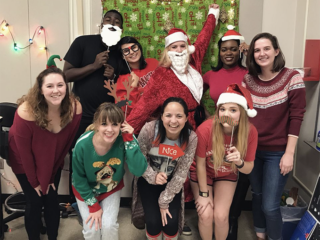A couple of buzz words that we hear a lot of today in academia are community, culture, and collaboration. While the meaning and idea of those words are incredible to find in the academic setting, the words themselves when used are usually trite and perfunctory because there isn’t much action put behind them. This is the case when used in faculty meetings and sadly, in the classroom.
The idea of faculty culture and collaboration can at times be stymied by bureaucratic processes, ranks, faculty egos, and generational traits (individualism, competition, etc.). With that said, students tend be less hindered by these. Younger students have yet to create full-fledge egos, both Generations Y and Z are more apt to working together making them less negatively competitive, and as students there are no bureaucratic processes or ranks. So why is community, culture and collaboration difficult for students to create? Faculty.
Students have no power in the classroom or in larger department/areas. Some organizations are beginning to implement student advisory committees but most students who serve in these roles feel obligated not to “ruffle feathers” or to disagree with faculty out of fear of damaging retaliation that may disrupt their academic advancement on top of all that, decisions made by these advisory committees rarely have teeth. At the classroom level students have few opportunities to provide feedback about their experience beyond the classic teacher evaluations and exit surveys. Because of this, students are dependent on supportive faculty to create pathways and opportunities for student expression, assembly and governance.
As written in some previous posts some faculty can be complacent and highly adverse to change. In addition, many faculty believe themselves to be omniscient to student needs and pedagogy. It is easy at times as a faculty member to fall into the trap of believing that our experience is applicable to all students but theories of group/classroom dynamics run in direct opposition to this thought. This omniscience can come across as adversarial which can create a toxic and demoralizing experience. Inactive and complacent faculty can be just as damaging at times by appearing to devalue the student experience through apparent neglect and lack of concern. Students tend to see complacent faculty as useless or “deaf ears” when considering expressing concerns and seeking change.

Annual Laser Tag Event 
Advanced Adobe Illustrator Workshop
As much as faculty can be an obstacle to a student’s community, culture and collaboration opportunities they can also be the primary advocate and facilitator. One method that can help make this happen is in-class techniques such as creating moments for open discussion and debate along with surveys which can allow an educator to involve students in future decision making while also allowing them to feel heard and valued. This along with methods I’ve written and presented on in the past such as in-class exercises, play days, competitions and challenges, help to create a sense of community during the in-class experience.
A good classroom experience is crucial to any education but I strongly believe that as great as it can be it is minor to what happens outside of it. As faculty we rarely consider having an effect on students outside of the classroom other than through stress inducing projects and assignments but, with a little service a faculty member’s impact can be much more. Especially if that service is through serving as an advisor of a student organization. I have served as a faculty advisor for student organizations every year of my teaching career (12 years) at three different universities and served as a president and founding member of two student organizations at my alma mater. I feel confident in saying that the greatest catalyst I’ve seen for students to create community, culture and collaboration is in an active and engaging student organization.
Through student organizations students are given a sense of autonomy which allows for opportunity to express themselves, govern themselves, and collaborate. Through this additional interaction students are able to use the common thread of being classmates and having similar goals to weave together something that is all their own. As with any community it should be led by members of that community. If a faculty member becomes too involved then organization meetings will be seen as just an extension of that faculty member’s classroom or course work (more on this in Part II).

Through the additional interaction created by their community students will begin to converse, critique, encourage and as a result a community and culture will begin to form along with an environment that is conducive for collaboration. Most of the time this can be seen as a positive but just as a complacent or adversarial faculty member can create a toxic classroom so too can “bad actors” or negative students create a toxic community. It will be vital for student leaders and the faculty advisor alike to watch for growing toxicity and work to remedy negative waves that may move through an organization during a semester.
This student constructed community and culture will filter into nearly every classroom and will ultimately affect a student’s perception on their entire college education. A quality student culture will raise morale which will filter into better student work, student to student relationships, faculty to student relationships and more. Like dominoes falling or a virus spreading other things beyond the classroom will begin to be affected by this increased morale as well such as recruitment and overall brand perception of the overall program.






